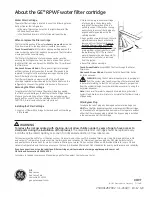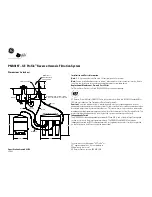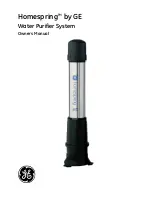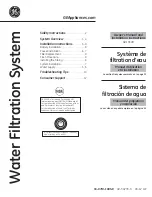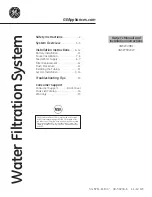
3
(9.5 to 19.0 Nm) of torque; a
tangential force of 14 to 28 lbs.( 62.3
to 124.5 N) delivered through a 6"
(152.4 mm) handle will deliver
adequate torque. Torque levels over
21 ft. lbs.(28.6 Nm) may distort the
orifice seal, resulting in leakage.
Step 5. Leave the protector cap in
place until the installation is finished.
When the system is ready for service,
remove the cap.
Step 6. To install the escutcheon
plate, align it with and press it over
the sprinkler body until the outer edge
of the escutcheon meets the
mounting surface.
Caution: Special care must be taken
when installing with a CPVC piping
system. Sprinklers must be installed
after the CPVC manufacturer’s
recommended setting time for the
primer and cement to ensure that no
primer or cement accumulates within
the sprinkler.
Special care must be taken when
installing with a copper system. The
sprinkler must be installed only after
the inside of the sprinkler drops and
associated fittings have been wire
brushed to remove any flux. Residual
flux can cause corrosion and can
impair proper sprinkler operation.
Technical
Data
Design Requirements — Residential Applications
(160
°
F/71
°
C Rating Only)
Maximum
Maximum
Minimum Design Flow (pressure)
Spacing Between
Location From
Sprinklers
Any Wall
One Sprinkler
Two or More Sprinklers
12 ft. (3.7 m) 6 ft. (1.8 m) 19 GPM (11.5 psi) 16 GMP (8.1 psi)
(72.0 L/min 0.8 bar) (60.6 L/min 0.6 bar)
14 ft. (4.3 m) 7 ft. (2.1 m) 25 GPM (19.9 psi) 18 GPM (10.3 psi)
(94.8 L/min 1.4 bar) (68.2 L/min 0.7 bar)
16 ft. (4.9 m) 8 ft. (2.4 m) 30 GPM (28.7 psi) 21 GPM (14.1 psi)
(113.7 L/min 2.0 bar) (79.6 L/min 1.0 bar)
18 ft. (5.5 m) 9 ft. (2.7 m) 32 GPM (32.7 psi) 29 GPM (26.8 psi)
(121.3 L/min 2.3 bar) (109.9 L/min 1.8 bar)
Design Requirements — Quick Response Extended Coverage
Applications
(145
°
F/63
°
C or 160
°
F/71
°
C)
Maximum
Maximum
Minimum
Minimum
Spacing Between
Location From
Design
Design
Sprinklers
Any Wall
Flow
Pressure
14 ft.
(or less)
(4.3 m) 7 ft.
(or less)
(2.1 m) 26
GPM
(98.5
L/min
) 21.6 psi(1/5 bar)
16 ft. (4.9 m) 8 ft. (2.4 m) 26
GPM
(98.5
L/min
) 21.6 psi (1.5 bar)
18 ft. (5.5 m) 9 ft. (2.7 m) 32
GPM
(121.3
L/min
) 32.7 psi (2.3 bar)
20 ft. (6.1 m) 10 ft. (3.0 m) 40
GPM
(151.6
L/min
) 51.0 (3.5 bar)
Listed for use in Light Hazard applications only.
* 20 foot spacing is not Listed as quick response.
The Model EC-20A Sprinkler must
be installed according to current
NFPA 13, NFPA 13D or NFPA 13R
standards. Deviations from these
requirements and standards or any
alteration to the sprinkler itself will
void any warranty made by Central
Sprinkler Company. In addition,
installation must also meet local
government provisions, codes, and
standards as applicable.
The system piping must be
properly sized to ensure the minimum
flow rate at the sprinkler. Check for
the proper model, style, orifice size,
and temperature rating prior to
installation. Install sprinklers after the
piping is in place to avoid mechanical
damage; replace any damaged units.
Wet pipe systems must be protected
from freezing.
Upon completion of the
installation, the system must be
tested per recognized standards.
In the event of a thread leak,
remove the unit, apply new pipe joint
compound or tape, and reinstall.
*Teflon is a trademark of the DuPont Corp.
Care &
Maintenance
Installation
Installation Sequence
Step 1. The unit must be installed in
the pendent position.
Step 2. The face of the sprinkler
fitting should be installed a nominal
1
1
/
8
" (28.6 mm) (plus or minus
7
/
16
"
(11.1 mm) behind the finished ceiling
line. Adjustments may be made via
the push-on escutcheon plate.
Do not use the push-on
escutcheon plate to hold the unit in
position. The sprinkler will only
function properly when the system
piping is anchored to the building
structure. Otherwise, reaction forces
from system initiation could alter the
sprinkler alignment and disrupt the
distribution pattern.
Step 3. Use only a non-hardening
pipe joint compound or Teflon* tape.
Apply only to the male threads.
Step 4. Hand tighten the sprinkler
into the fitting. Leaving the protector
cap in place, use a Central Sprinkler
Omega Model A sprinkler wrench to
tighten the unit in the fitting. A leak
tight joint requires only 7 to 14 ft. lbs.
Sprinklers must be handled carefully.
They must not be transported or stored
where ambient temperature may
exceed 100
°
F/38
°
C. For best results,
store them in a cool, dry location in the
original shipping package.
Do not install sprinklers that have
been dropped or visibly damaged.
Sprinklers must never be painted,
coated, plated or altered in any other
way from manufactured condition or
they may not function properly. Any
sprinklers altered in such manner must
be replaced.
The owner is responsible for the
proper operating condition of all fire
protection devices and accessories.
The NFPA standard 25 entitled,
“Inspection, Testing and Maintenance of
Water-Based Fire Protection Systems”,
contains guidelines and minimum
OBSOLETE





